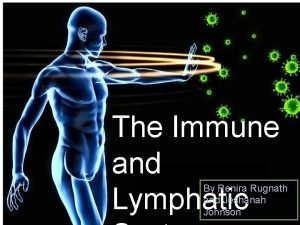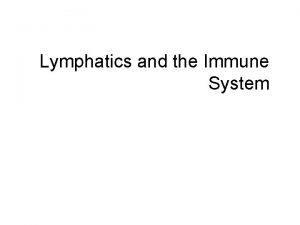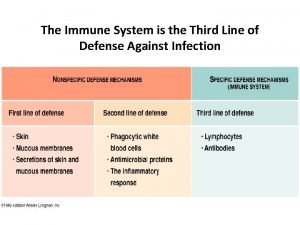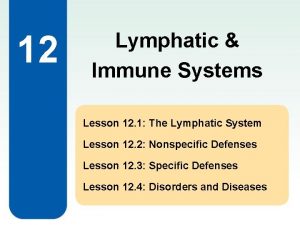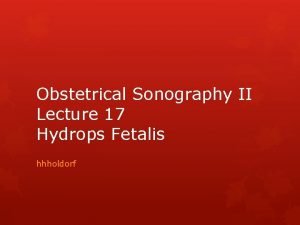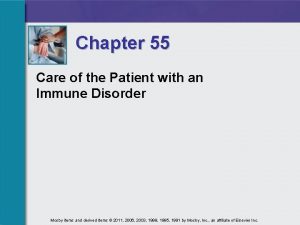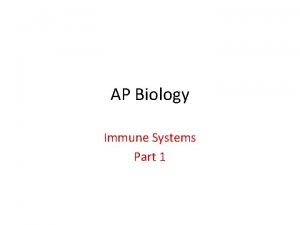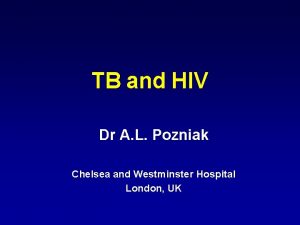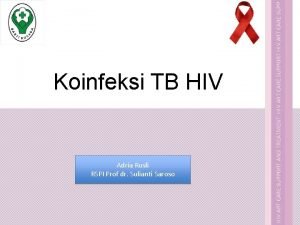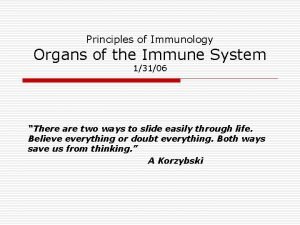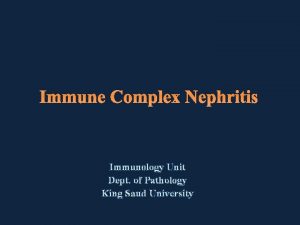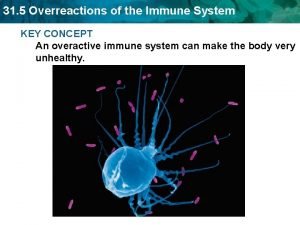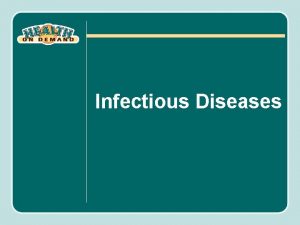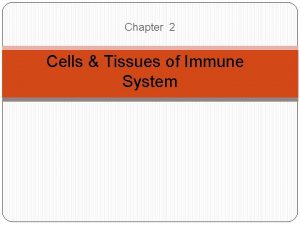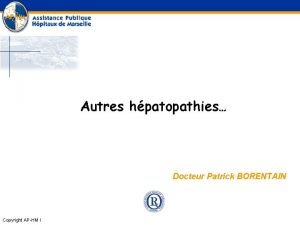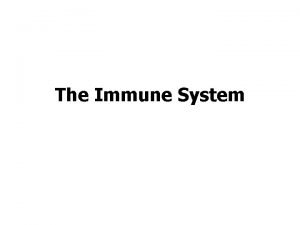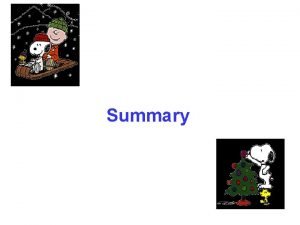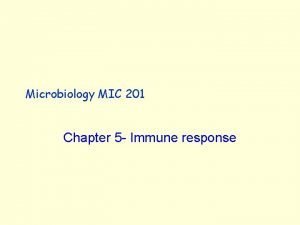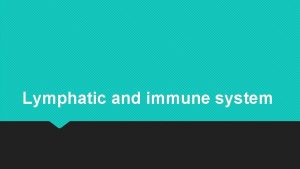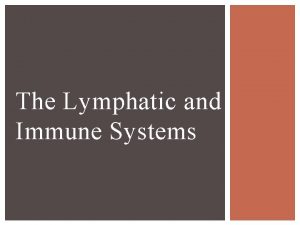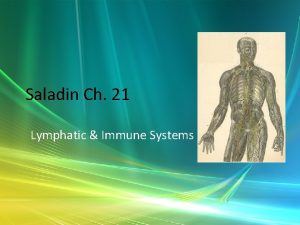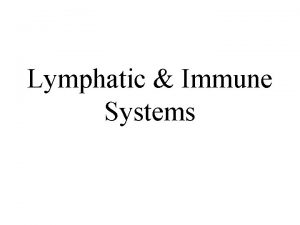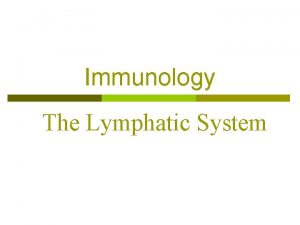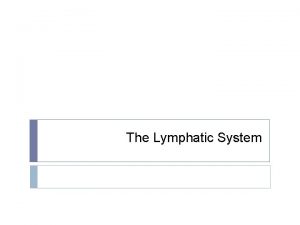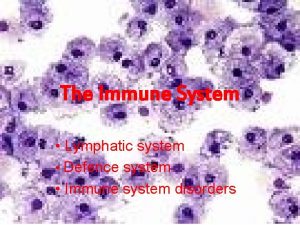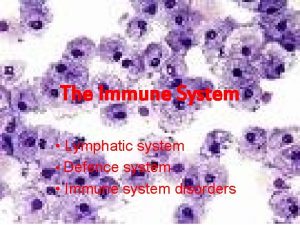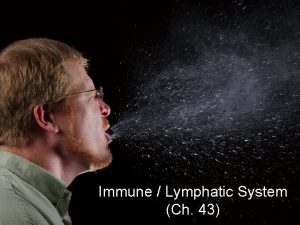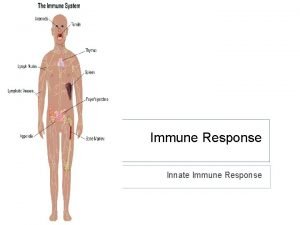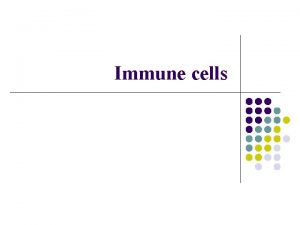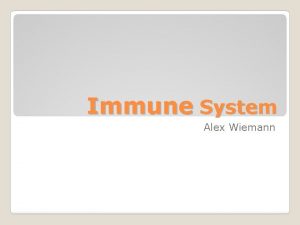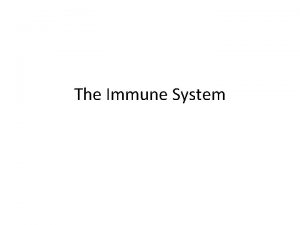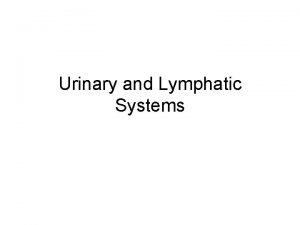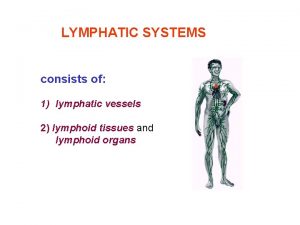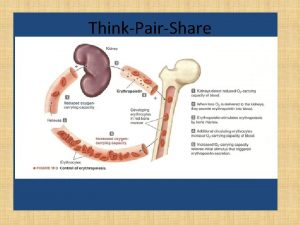12 Lymphatic Immune Systems Lesson 12 1 The





































- Slides: 37

12 Lymphatic & Immune Systems Lesson 12. 1: The Lymphatic System Lesson 12. 2: Nonspecific Defenses Lesson 12. 3: Specific Defenses Lesson 12. 4: Disorders and Diseases

Chapter 12: The Lymphatic and Immune Systems Lesson 12. 1 Lymphatic System

Outline: Lymphatic System • Organization of the lymphatic system – Lymph formation and flow – Lymph drainage • Lymphatic cells, tissues, and organs – Lymphatic cells – Lymphatic tissues – Lymphatic organs © Goodheart-Willcox Co. , Inc. Permission granted to reproduce for educational use only.

Lymphatic System • Functions – Removes antigens from the body – Exposes antigens to the immune system – Returns fluid to the blood © Goodheart-Willcox Co. , Inc. Permission granted to reproduce for educational use only.

Movement of Fluids • Contraction of skeletal muscles against lymphatic vessels • Smooth muscle contraction − − Valves in lymphatic vessels Breathing • Obstruction of system leads to edema © Goodheart-Willcox Co. , Inc. Permission granted to reproduce for educational use only.

Lymph Formation and Flow • Fluid leaks out of blood vessel capillaries – ~4 liters per day • Enters lymphatic capillaries • Fluid is now called lymph • Returns to circulatory system through lymphatic trunks © Goodheart-Willcox Co. , Inc. Permission granted to reproduce for educational use only.

Lymph Drainage • Thoracic duct – Drains legs, abdominopelvic area, left arm, left side of the head and thorax • Right lymphatic duct – Drains right arm, right side of head, right side of the thorax © Goodheart-Willcox Co. , Inc. Permission granted to reproduce for educational use only.

Lymph Drainage © Goodheart-Willcox Co. , Inc. Permission granted to reproduce for educational use only.

Lymphatic Cells • Lymphocytes – T lymphocytes mature in thymus – B lymphocytes mature in bone marrow • Macrophages – “Eat” other cells – Leave lymphatic tissue to enter surrounding tissue © Goodheart-Willcox Co. , Inc. Permission granted to reproduce for educational use only.

Lymphatic Tissues • Mucosa associated lymphatic tissue (MALT) – Tonsils • Pharyngeal • Palatine • Lingual • Lymphatic nodules – – – Cervical Axillary Abdominal Inguinal Pelvic Lumbar © Goodheart-Willcox Co. , Inc. Permission granted to reproduce for educational use only.

Lymph Nodes • Concentration of immune cells • Nodes are found grouped together at various parts of the body • Filtration of blood © Goodheart-Willcox Co. , Inc. Permission granted to reproduce for educational use only.

Lymphatic Nodes • Lymph nodes – Cleanse lymph – Store / produce T & B cells © Goodheart-Willcox Co. , Inc. Permission granted to reproduce for educational use only.

Lymphatic Organs • Spleen – Production and removal or RBCs – Scans and cleans blood • Thymus – Maturation of T cells © Goodheart-Willcox Co. , Inc. Permission granted to reproduce for educational use only.

Spleen • Largest lymphatic organ • Located in the upper left quadrant of abdominal cavity • Functions − Filters blood similarly to lymph nodes − Removes worn-out red cells − If removed (splenectomy), liver takes over most of its function © Goodheart-Willcox Co. , Inc. Permission granted to reproduce for educational use only.

Thymus • Located just above the heart in the mediastinum • Large in children, shrinks as we age • Functions − Same as lymph node − Also produces lymphocytes − Produces thymosin – stimulates production of lymphocytes © Goodheart-Willcox Co. , Inc. Permission granted to reproduce for educational use only.

Organization of the Lymphatic System • • Tonsils Cisterna chyli Spleen Lymph nodes – – – Cervical Axillary Inguinal Pelvic Lumbar Abdominal © Goodheart-Willcox Co. , Inc. Permission granted to reproduce for educational use only.

Chapter 12: The Lymphatic and Immune Systems Lesson 12. 2 Nonspecific Defenses

Nonspecific Defenses • • Physical barriers Cellular and chemical defenses Inflammatory response Fever © Goodheart-Willcox Co. , Inc. Permission granted to reproduce for educational use only.

Physical Barriers • Skin • Hair • Acidic secretions (sebaceous & sudoriferous glands) • Mucous membranes © Goodheart-Willcox Co. , Inc. Permission granted to reproduce for educational use only.

Cellular and Chemical Defenses • Phagocytosis – Neutrophils – Macrophages – Engulf foreign cells and debris – Exocytosis • Natural killer cells – Release perforins to perforate cells © Goodheart-Willcox Co. , Inc. Permission granted to reproduce for educational use only.

Inflammatory Response • Promotes repair of damaged tissue • Histamines released by mast cells • Symptoms – – Heat Redness Swelling Pain © Goodheart-Willcox Co. , Inc. Permission granted to reproduce for educational use only.

The Development of Inflammation • Tissue damage occurs • Intracellular contents are released from damaged cells into interstitial fluid • Mast cells release histamine • Blood vessels dilate, blood flow increases, capillary permeability increases • Clot formation occurs • Scar tissue forms, replacement cells grow © Goodheart-Willcox Co. , Inc. Permission granted to reproduce for educational use only.

Fever • Higher than normal body temperature • Activation of leukocytes & macrophages causes release of pyrogens • Hypothalamus raises body temperature = fever © Goodheart-Willcox Co. , Inc. Permission granted to reproduce for educational use only.

Chapter 12: The Lymphatic and Immune Systems Lesson 12. 3 Specific Defenses

Specific Defenses • • Antigens Immune system cells Primary and secondary immune responses Cellular immunity © Goodheart-Willcox Co. , Inc. Permission granted to reproduce for educational use only.

Antigens • On the surface of cells – Proteins • Determine “self” from “nonself” cells © Goodheart-Willcox Co. , Inc. Permission granted to reproduce for educational use only.

Immune System Cells • Lymphocytes – Recognize antigen – Memory cells • MHC proteins – Display fragments of the ingested microbe to T cells © Goodheart-Willcox Co. , Inc. Permission granted to reproduce for educational use only.

Humoral Immunity • Antibodies – Also called immunoglobulins – Y-shaped proteins which recognize, bind to, and mark antigens (viruses and bacteria) – Every different antibody recognizes a specific foreign antigen © Goodheart-Willcox Co. , Inc. Permission granted to reproduce for educational use only.

Primary and Secondary Immune Responses • Primary immune response – When first exposed • Secondary immune response – Memory cells respond to invader • Active immunity – Exposed, infected, recovered • Passive immunity – Vaccination © Goodheart-Willcox Co. , Inc. Permission granted to reproduce for educational use only.

Cellular Immunity (T cells) © Goodheart-Willcox Co. , Inc. Permission granted to reproduce for educational use only.

Chapter 12: The Lymphatic and Immune Systems Lesson 12. 4 Disorders and Diseases of the Immune System

Disorders and Diseases of the Immune System • • cancer and lymph nodes allergies autoimmune disorders HIV and AIDS © Goodheart-Willcox Co. , Inc. Permission granted to reproduce for educational use only.

Cancer and Lymph Nodes • rapid, unregulated cell growth • metastasis – cancerous cells move within body • cancerous cells may lodge in lymph nodes © Goodheart-Willcox Co. , Inc. Permission granted to reproduce for educational use only.

Allergies • inappropriately strong response to a harmless environmental antigen • exposure to allergen causes release of histamine • histamine causes allergy symptoms – runny nose, itchy eyes, anaphylaxis • anaphylaxis • immunotherapy © Goodheart-Willcox Co. , Inc. Permission granted to reproduce for educational use only.

Allergies © Goodheart-Willcox Co. , Inc. Permission granted to reproduce for educational use only.

Autoimmune Disorders • immune system attacks own body • cause unclear • examples – rheumatoid arthritis – multiple sclerosis – type I diabetes © Goodheart-Willcox Co. , Inc. Permission granted to reproduce for educational use only.

HIV and AIDS • HIV – infects and kills helper T cells • AIDS – helper T cell count falls below 200/mm 3 – immune system seriously weakened – patient is susceptible to opportunistic infection © Goodheart-Willcox Co. , Inc. Permission granted to reproduce for educational use only.
 Chapter 24 the immune and lymphatic systems and cancer
Chapter 24 the immune and lymphatic systems and cancer What empties into the left subclavian vein
What empties into the left subclavian vein Primary immune response and secondary immune response
Primary immune response and secondary immune response Lymphatic vs immune system
Lymphatic vs immune system Phagocitize
Phagocitize What are the first line of defense
What are the first line of defense Lesson 12.1 lymphatic ducts and vessels
Lesson 12.1 lymphatic ducts and vessels Lesson 12 blood and immune system
Lesson 12 blood and immune system What is the third line of defense in the immune system
What is the third line of defense in the immune system Complete the flow chart
Complete the flow chart Any substance capable of provoking an immune response
Any substance capable of provoking an immune response Spalding sign
Spalding sign Difference between innate and learned behavior
Difference between innate and learned behavior 1st line of defense immune system
1st line of defense immune system Chapter 35 immune system and disease
Chapter 35 immune system and disease Chapter 55 care of the patient with an immune disorder
Chapter 55 care of the patient with an immune disorder What is the third line of defense in the immune system
What is the third line of defense in the immune system Ap bio immune system
Ap bio immune system Immune checkpoint inhibitors mechanism of action
Immune checkpoint inhibitors mechanism of action Immune reconstitution inflammatory syndrome
Immune reconstitution inflammatory syndrome Immune reconstitution inflammatory syndrome
Immune reconstitution inflammatory syndrome Immune system lymph nodes
Immune system lymph nodes Immune system definition
Immune system definition Immune complex glomerulonephritis
Immune complex glomerulonephritis Overreactions of the immune system
Overreactions of the immune system Nct03946670
Nct03946670 Defination of infection
Defination of infection Primary immune response
Primary immune response Immune effector cells
Immune effector cells Unsaturated alcohol crossword clue
Unsaturated alcohol crossword clue Hepatite auto immune fmc
Hepatite auto immune fmc Antigen defintion
Antigen defintion Lupus
Lupus The main function of immune system
The main function of immune system Primary and secondary immune response
Primary and secondary immune response Cellular immune response
Cellular immune response Ctl
Ctl Cellular immune response
Cellular immune response



